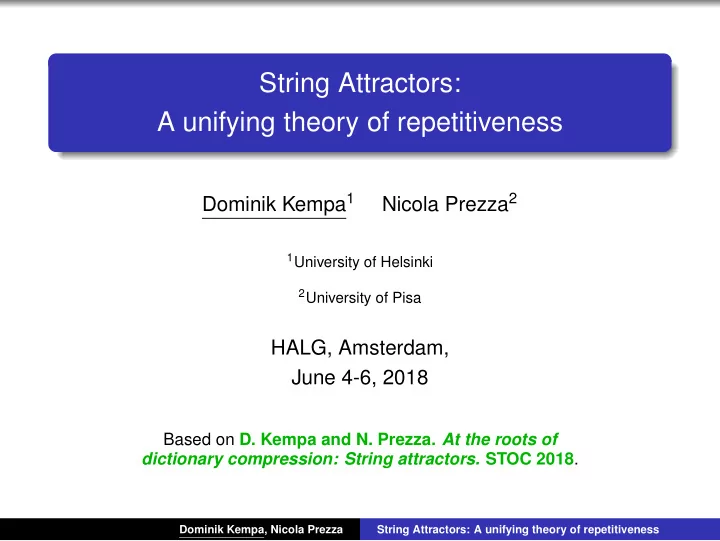

String Attractors: A unifying theory of repetitiveness Dominik Kempa 1 Nicola Prezza 2 1 University of Helsinki 2 University of Pisa HALG, Amsterdam, June 4-6, 2018 Based on D. Kempa and N. Prezza. At the roots of dictionary compression: String attractors. STOC 2018 . Dominik Kempa, Nicola Prezza String Attractors: A unifying theory of repetitiveness
Background: Dictionary compression Definition Dictionary compression : Encoding of string that replaces repetitions with pointers to other occurrences. Example: Lempel-Ziv ’77 (LZ77) LZ77 = Greedy left-to-right partition of text into longest previous factors. T = B A B B A B A B B B A B Encoding: ( b ,0),( a ,0),(1,1),(1,3),(2,3),(4,3) Dominik Kempa, Nicola Prezza String Attractors: A unifying theory of repetitiveness
Background: Dictionary compression Example: Run-length Burrows-Wheeler transform (RLBWT) RLBWT = invertible text transformation defined as follows. Input: text T = BANANA$ 1. Build a matrix 2. Sort the rows 3. Apply run-length with the text compression to L = ANNB$AA rotations as rows L (the last column) B A N A N A $ $ B A N A N A A N A N A $ B A $ B A N A N N A N A $ B A A N A $ B A N A N A $ B A N A N A N A $ B N A $ B A N A B A N A N A $ A $ B A N A N N A $ B A N A $ B A N A N A N A N A $ B A Output: RLBWT = ( 1 , A ) , ( 2 , N ) , ( 1 , B ) , ( 1 , $ ) , ( 2 , A ) Dominik Kempa, Nicola Prezza String Attractors: A unifying theory of repetitiveness
Background: Dictionary compression Other (less known) dictionary compressors: (run-length) grammars (SLP) collage systems macro schemes word graphs (CDAWG) Applications Compression : reducing the size of data before archiving or transfer, e.g., over the network. Examples: 7-zip, gzip = LZ77. Compressed computation : supporting operations on data structures taking space close to dictionary-compressed text. Example operations: random access pattern matching queries Dominik Kempa, Nicola Prezza String Attractors: A unifying theory of repetitiveness
String Attractors New combinatorial object generalizing all known dictionary compressors. Definition A set Γ ⊆ [ 1 .. n ] is a string attractor of T ∈ Σ n if every substring of T has an occurrence containing an element of Γ . Example T = CDABCCDABCCA Γ = { 3 , 6 , 10 , 11 } Theorem: “compressors are attractors” Let T ∈ Σ n and let α be the output size of any the following dictionary compressors on T : (1) (RL)SLP , (2) collage system, (3) LZ77, (4) macro scheme, (5) RLBWT, (6) CDAWG. Claim: T has a string attractor of size O ( α ) . T = B A B B A B A B B B A B Example: Dominik Kempa, Nicola Prezza String Attractors: A unifying theory of repetitiveness
String Attractors Theorem (bad news) Computing the smallest attractor is NP-complete and APX-hard. But, the reduction Compressors → Attractors can be reversed! Theorem: Given a string T ∈ Σ n and a string attractor Γ of size γ for T , we can build a macro scheme for T of size O ( γ log ( n / γ )) , a collage system for T of size O ( γ log ( n / γ )) , an SLP for T of size O ( γ log 2 ( n / γ )) . Consequence : many new (and easier proofs of existing) relations between sizes of dictionary compressors, for example, z ∈ O ( r log 2 ( n / r )) , where z (resp. r ) is the size of LZ77 (resp. RLBWT). Dominik Kempa, Nicola Prezza String Attractors: A unifying theory of repetitiveness
String Attractors String attractors carry enough information about the string to design data structures. Theorem If T ∈ Σ n has an attractor of size γ , then we can build a data structure of size O ( γ polylog n ) w -bit words that can extract any length- ℓ substring of T in O ( ℓ log ( σ ) / w + log n / log log n ) time. O ( γ log ( n / γ )) that, given a pattern P [ 1 .. m ] , outputs all its occurrences in T in O ( m log n + occ log ǫ n ) time. The resulting data structures are universal thanks to reductions Attractors → Compressors , i.e., they translate to concrete data structures working on different compressed representations. Dominik Kempa, Nicola Prezza String Attractors: A unifying theory of repetitiveness
Thank You! Dominik Kempa, Nicola Prezza String Attractors: A unifying theory of repetitiveness
Recommend
More recommend